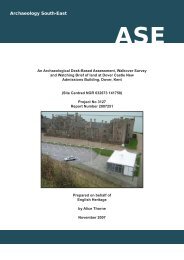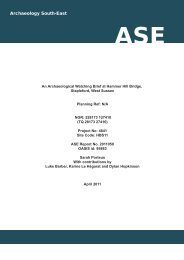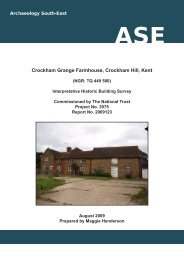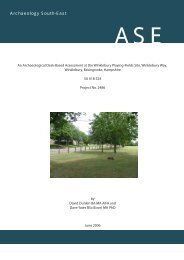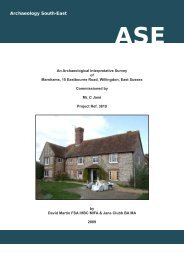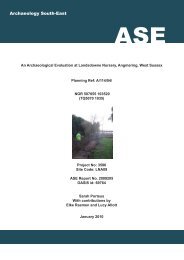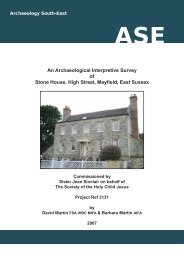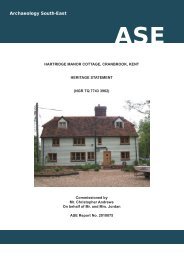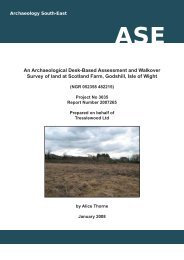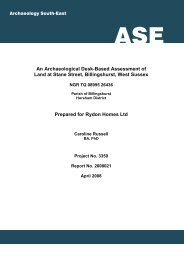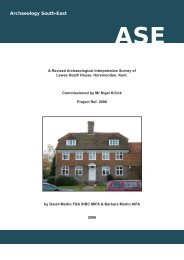ASE front cover - Archaeology South-East
ASE front cover - Archaeology South-East
ASE front cover - Archaeology South-East
Create successful ePaper yourself
Turn your PDF publications into a flip-book with our unique Google optimized e-Paper software.
<strong>Archaeology</strong> <strong>South</strong>-<strong>East</strong>2008058: Holbury Infants School, Holbury, Hampshire5.1.2.4 Around 5% of the assemblage was identified as Alice Holt reduced ware,mostly the black-slipped Overwey fabric variant. Despite intensification inproduction at Alice Holt after AD 270, the products were not supplied ingreat numbers to south Hampshire because the market was saturated byNew Forest products (Lyne & Jefferies 1979, 56). Again the majority are BBrelated jars, bead and flange bowls and plain rim dishes, with threeexamples of lids. There are two residual sherds of early Alice Holt-Surreyware, which went out of production around the mid 2 nd century. Onedistinctive form in the Alice Holt/Farnham ware, a bead rim jar with a widezone of diagonal line decoration, has more affinities with forms from theearlier industry and was fairly uncommon after AD 250 (e.g. Lyne &Jefferies 1979, 4.31, fig 15, 29). However, the upper part of the vessel issemi-complete suggesting that it survived in use with pottery dated to afterAD 270.5.1.2.5 There are a small number of Rowland’s Castle greyware sherds includingone from a necked storage jar. The main distribution of Rowland’s Castleware is eastwards along the route of Stane Street to Chichester, and itwould not be expected in any quantity in Hampshire, again because ofcompetition from the New Forest industry (Fulford 1974, 92-94).5.1.2.6 BB1 is among the most common fabrics in the assemblage, accounting forabout 10-15% of the total. This high figure is unsurprising as the site islocated less than 50km from the production source and production wasparticularly intensive in the 3 rd and 4 th centuries. There are slightly moreopen than closed vessels and the plain rim dish and high bead and flangebowl forms are particularly common.5.1.2.7 Coarse oxidised wares only account for around 3% of the assemblage andmost of these are unsourced. Among this group are two mortaria withinturned beads and straight flanges featuring very coarse ill-sorted flint grits,up to 4mm in size which are not fully calcined. These are very different toNew Forest examples but the coarseness of the grits suggests they are theproducts of a less specialised local industry. The only other forms are anecked jar in an orange oxidised ware containing glauconite and the base ofa tall beaker probably imitating New Forest forms. Just under half of theoxidised wares are New Forest white ware and include a pulley rim flagonmore usually found in colour-coated wares (e.g. Fulford 1975b, 7.1, fig 9,47) and a bead and flange mortarium similar to Fulford’s type 103; theformer is dated to AD 300-360 and the latter to AD 270-320.5.1.2.8 Although Holbury is near the edge of the normal distribution area forPortchester D ware it is notable that there is only one sherd in theassemblage. Although this fabric was first produced at the start of the 4 thcentury, it had a wider distribution from the mid 4 th century and its nearabsence in the assemblage probably indicates that activity on site hadlargely ceased by this date.5.1.2.9 Fine-wares make up about 10% of the assemblage, most of which are NewForest wares, including high-fire and red-slipped variants. All the high firedsherds are from beakers, mostly tall funnel necked types with bulbousbodies which are variants of Fulford’s type 30, produced from the early 4 thcentury (Fulford 1975b, fig 13, 55). One example is interesting because itfeatures barbotine scales which are normally only found on bag-shaped20© <strong>Archaeology</strong> <strong>South</strong>-<strong>East</strong>



